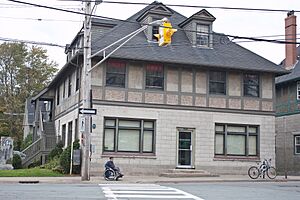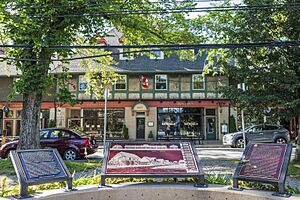Hydrostone facts for kids
Quick facts for kids
Hydrostone
|
|
|---|---|
|
Neighbourhood
|
|

Storefronts in the Hydrostone district of Halifax
|
|
| Country | Canada |
| Province | Nova Scotia |
| Municipality | Halifax Regional Municipality |
| Community | Halifax |
| Area | |
| • Total | 9.3 ha (23.0 acre) |
| Time zone | UTC−04:00 (AST) |
| Area code(s) | 902 |
|
|
|
| Official name: Hydrostone District National Historic Site of Canada | |
| Designated: | 1993 |
Hydrostone is a special neighbourhood in the North End of Halifax, Canada. It has ten short streets that run side-by-side. The area is about 9.3 hectares (23 acres) in size.
This neighbourhood was built after a huge disaster. In 1917, the Halifax Explosion destroyed many homes. Architect Thomas Adams designed Hydrostone to create new houses for the families who lost theirs. The buildings were designed by George Ross from the Montreal firm Ross and Macdonald. The name "Hydrostone" comes from the unique concrete blocks used to build the houses. Most homes are row-houses, meaning they are joined together in groups.
The streets in Hydrostone are like boulevards, with tree-lined grassy areas in the middle. These green spaces are for everyone in the neighbourhood to enjoy. This design was inspired by the "Garden City movement," which aimed to create green, healthy living spaces. Also, the streets have back lanes, which are common in Western Canada but not usually seen in Eastern Canadian towns.
Today, Hydrostone is recognized as a National Historic Site of Canada. This means it's an important place in Canadian history.
Why Hydrostone Was Built
After the Halifax Explosion, many wooden buildings caught fire because they collapsed onto stoves and furnaces. When it was time to rebuild, planners wanted to make sure this wouldn't happen again. Thomas Adams and George Ross decided to use a special fire-resistant material called hydrostone. This would make the new homes much safer.

Hydrostone is a type of concrete block. It was made to look like cut stone by adding crushed rock, like granite, to its surface. These blocks were created using a special hydraulic pressing process. The blocks were made in a plant in Eastern Passage. Then, they were brought across Halifax Harbour by large boats called barges.
Getting the heavy stones from the harbour up to the building site was a challenge because the land was very steep. To make it easier, two new diagonal streets, Devonshire Street and Dartmouth Avenue, were added to the rebuilding plans for the Richmond district.
Hydrostone Today

Today, Hydrostone is a very popular place to live. Many young professionals and small families want to live there because of its nice green spaces and its closeness to shops and public transport. These new residents often buy and fix up the older homes. This has made property values go up, which sometimes means that people who have lived there for a long time find it harder to afford to stay.
In 2011, the Canadian Institute of Planners held a contest called "Great Places in Canada." They named Hydrostone the second greatest neighbourhood in the country!

